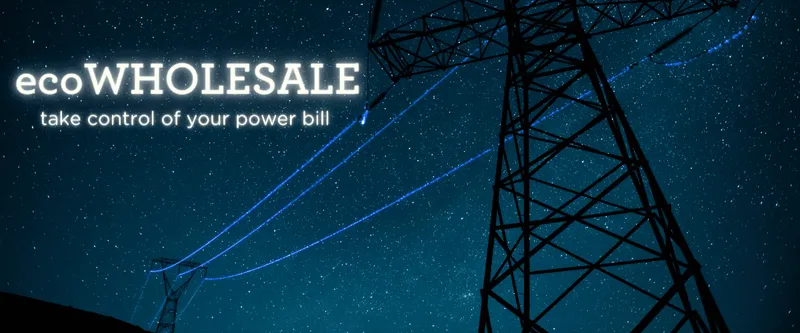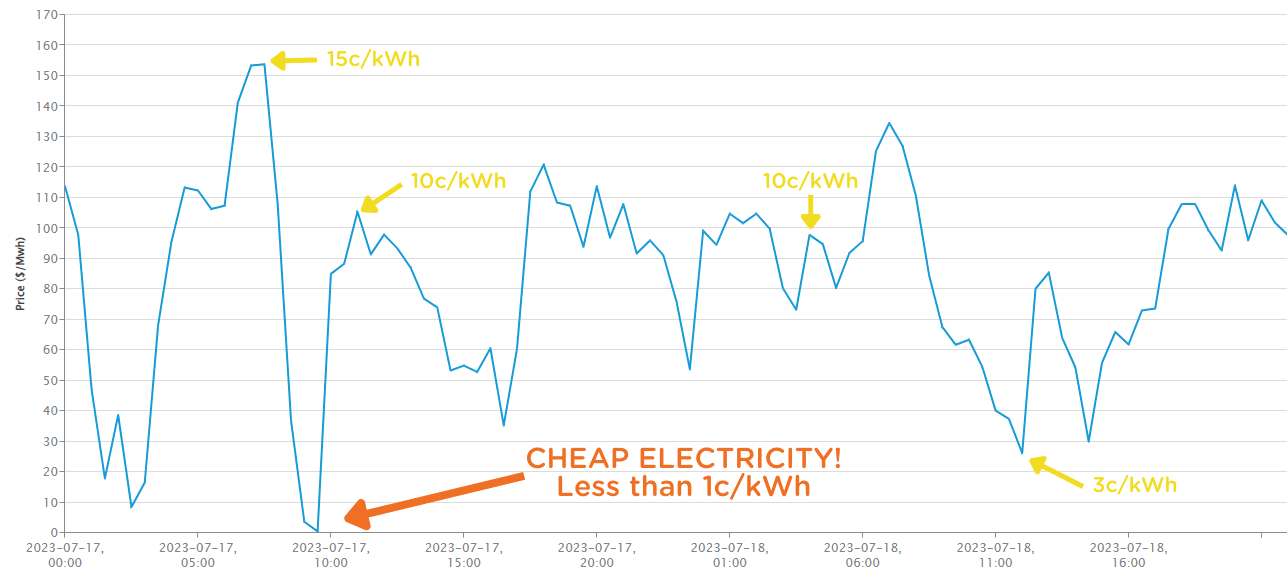ecoWHOLESALE Explained: The ins and outs of a spot price-based energy plan
03/08/2023

Electricity is an essential component of modern life, powering our homes, businesses, and industries. In New Zealand, electricity providers offer a variety of pricing plans to meet the diverse needs of consumers.
Ecotricity’s ecoWHOLESALE plan allows customers to pay for electricity based on the fluctuating wholesale spot market prices.
Electricity prices can get below 2 c/kWh for extended periods, a great time to charge your electric vehicle or do a load of washing! See the graph below for examples of extremely low wholesale electricity prices.
Over the long term, spot pricing can be the cheapest way to purchase electricity where customers are able to move some of their load like electric vehicle charging or residential battery charging to off peak times.
Graph showing electricity spot price forecast over two days in July 2023

Graph source: www2.electricityinfo.co.nz. Spot based forecast for the next 36 hours: North Island (Otahuhu). Spot based forecast for the next 36 hours: South Island (Benmore). (Note, to convert from $MWh to c/kWh, divide by 10)
How Do Spot Price-Based Electricity Plans Work?
Spot price-based electricity plans, also known as real-time pricing or wholesale pricing plans, are based on the actual market price of electricity at any given moment which operates on a half hourly basis. Unlike fixed-rate plans, where customers pay a predetermined rate for their electricity consumption, spot price-based plans reflect the current wholesale market price. (Electricity distribution losses* are not included in the wholesale market price).
Spot prices are influenced by various factors, including supply and demand dynamics, weather conditions, generation capacity, and transmission constraints. These factors can cause significant fluctuations in electricity prices throughout the day, but also great opportunities to choose ultra cheap 100% renewable electricity! ecoWHOLESALE customers are billed monthly as normal on the half-hourly spot prices plus a small admin fee.

Advantages of Spot Price-Based Electricity Plans
- Beat the Market = Cost Savings: Spot price-based plans can provide potential cost savings for consumers who are flexible with their electricity usage. During times of low demand or abundant renewable generation, spot prices can drop significantly, allowing customers to benefit from super cheap electricity.
- Price Transparency: Spot price-based plans provide transparency by directly linking electricity costs to the wholesale market price. This allows customers to understand and monitor electricity pricing fluctuations and make informed decisions about their energy consumption.
- Environmental Considerations: By aligning electricity usage with periods of high renewable energy generation, customers on spot price-based plans can actively support a cleaner and more sustainable energy system. Irrespective of when power is consumed, all electricity supplied by Ecotricity is 100% renewable and Toitū climate positive certified, however we do encourage customers to shift their energy load away from peak periods to help take pressure off the grid.
- Make it cheaper for your community: the more customers who move their load to off peak periods, the cheaper it gets for your neighbours and the rest of New Zealand during peak periods.
Considerations for Consumers
- Volatility and Uncertainty: Spot price-based plans expose customers to market volatility, meaning that prices can spike during periods of high demand or when there is a shortage of supply. Customers should be prepared for potential fluctuations in their monthly bills.
- Flexibility and Awareness: To maximize the benefits of spot price-based plans, it’s recommended that customers are flexible with their energy consumption patterns. Being aware of peak and off-peak periods and adjusting usage accordingly to help save money.
- Risk Tolerance: Consumers must assess their risk tolerance and ability to absorb potential price increases. For some, the certainty of a fixed-rate plan may be preferable, while others may be willing to take on the risk associated with spot price-based plans for potential cost savings.

Image by: Solartive & Solar One.
When are spot prices typically higher or lower?
- Higher: Electricity usage is generally highest during the early morning hours, as well as in the early evening when people are at home and there is a lot of activity. Additionally, during colder months, electricity consumption naturally rises due to a higher demand of heating and other appliances.
- Lower: Our power consumption tends to decrease during the middle of the day when we’re away from home, as well as in the middle of the night when we’re asleep. Additionally, power usage is generally lower in the summer, there is less of a need to heat homes, and many appliances are used less.
Are spot prices the same around the country?
Spot prices do vary around the country and are determined by which Grid Exit Point (GXP) you are using. Your GXP is where electricity flows out of the National Grid and into your local power lines – there are 180 GXPs across NZ.
Generally speaking, the further away you are from NZ’s generation sites, the higher the energy cost will be. As hydro generation accounts for a significant portion of our total energy generation and the bulk of our hydro comes from the South Island, we typically see lower prices down south.
Who Can Benefit from Spot Price-Based Electricity Plans?
Considering all of the above, spot price-based electricity plans are appealing to those who have higher electricity consumption outside of peak periods and can easily flex their time of usage – this is particularly true for EV owners and households with solar battery systems.
- EV Owners: With a spot price-based plan, customers can take advantage of lower electricity prices (typically overnight), leading to significant cost savings. By using smart charging technology, EV owners can schedule their charging sessions to align with these periods.
- Households with Solar Battery Systems: Households can charge their batteries when solar production is at its peak. They can then utilize this stored energy during times of higher electricity demand. By avoiding the need to draw electricity from the grid at these times, consumers can reduce their reliance on spot-priced electricity and save money.

Tips to best manage the risks on a wholesale-based energy plan
- Monitor spot prices: There are several sites that give you access to wholesale electricity prices. Bookmark North Island OR South Island so you can easily monitor real-time prices and view a 72 hour price forecast to take advantage of lower prices, and avoid the peaks.
- Keep an eye out for Ecotricity alerts: If we see wholesale prices spiking we'll send out a text alert recommending you limit your energy consumption.
- Utilize smart energy technologies: These devices can help you track and manage your energy consumption for individual appliances.
- Be flexible with energy usage: If possible, shift as much of your energy consumption to off-peak periods when prices are generally lower.
- Review the Electricity Authority (EA) Stress Test: The (EA) has conducted a stress test to assess the resilience of the electricity market during extreme events, and how it affects wholesale pricing. Read about the EA stress test, and test how your energy usage fairs during extreme energy events.
As the electricity market continues to evolve, spot price-based plans will contribute to a more dynamic and responsive energy system in New Zealand, and at Ecotricity we’re proud to be a leader in this space with our ecoWHOLESALE plan. If you’re keen get an estimate for your house, please click here.
*Distribution losses: As electricity travels through power lines, a proportion of energy is lost as heat, due to the resistance in the lines. The losses are higher, the greater the distance the electricity travels and the lower the voltages of the line. The average distribution loss in New Zealand is 5.3%.
More info from the EA
Need more info? Download and read these guides from the Electricity Authority (EA):
Managing Electricity Spot Price Risk Flyer







